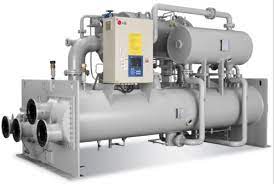
Amid excess heat, it becomes vital to ensure proper cooling for the comfort and ease of the occupants. If it is not done, productivity might lessen, and even the health of some individuals might be compromised. This is especially true in the case of industrial facilities where several machines work together and generate a lot of heat. This is why these facilities typically install a water-cooled chiller unit to ensure the smooth functioning of the facility. To know more about the water-cooled chillers and their types, read the following sections. Have a glance!
What is a water-cooled chiller?
A water-cooled chiller helps control the temperature of the indoors by using water as the secondary refrigerant. It is typically used for cooling larger and more complex facilities that help with district cooling, food and beverage processing, plastic processing, cold storage, hydroponics, centralized air conditioning, cold storage, and plastic processing.
The system facilitates heat transfer from the internal environment to the external environment. A water-cooled chiller can precisely transfer heat, has high energy efficiency, and comes with a longer lifespan. The unit features a cooling tower and uses the water transferred to condense the refrigerant. In these systems, the temperature and flow rate of condensing water (which relies on the ambient wet-bulb temperature) decides the refrigerant temperature. So, if the wet-bulb temperature is lower than the dry-bulb temperature, the condensing temperature of the refrigerant is significantly lower and more efficient.
What are the types of water-cooled chillers?
Primarily water-cooled chillers are of two types, stationary water-cooled central chillers and portable water-cooled central chillers.
- Stationery water-cooled central chillers:
These systems are a popular type of water-cooled chillers that are useful for cooling many processes in the plant simultaneously. The primary component in a stationary water-cooled chiller is the standalone chiller. It is connected through piping to a pump and a separate reservoir for functioning.
The stationery chillers feature individual controls for the chiller and the pump. The controls need to be wired together to prevent the electrical connection from cooling until the time the circulating pump is functioning.
2. Portable water-cooled chillers:
Because of its name, many people confuse the portability of these chillers with their mobility. But, you need to remember that most chiller units cannot be moved from their position once installed. The term portable in this type of water chiller refers to its basic configuration. So, any water-cooled system that comprises of all the essential components like a refrigeration circuit, pump, or reservoir within a single footprint is a portable unit.
In the case of the central portable chillers, the controls are integrated to include motor starters and need one point electrical connection.
The water-cooled chillers are efficient units that ensure maximum cooling in the minimal possible time. They are primarily of two types, stationary water-cooled central chillers and portable water-cooled chillers.